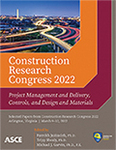Mistakeproofing Framework and Applications in Civil Engineering Operations and Products
Publication: Construction Research Congress 2022
ABSTRACT
This paper presents a theoretical framework and examples of a practice called “mistakeproofing” or “poka yoke” (in Japanese). Mistakeproofing is a concept integral to lean production, and it is also related to Prevention through Design (PtD) and resilience engineering. Mistakeproofing means to either reduce the likelihood of a mistake occurring in an operation or product, or to alleviate the impact an occurrence may have. This is achieved by judiciously altering the operation or product design. While it may be impossible to eliminate all occurrences of mistakes, any occurrence should be prevented from turning into a defect. Examples from civil engineering design and construction are illustrated, described by the concern addressed and the countermeasure offered, and characterized according to the six principles of mistakeproofing. Although these examples may look familiar to readers, a new perspective is offered by viewing them through the lens of mistakeproofing. The contribution of this paper is presenting the concept of mistakeproofing with its theoretical framework, and illustrating the use of that framework with civil engineering examples. The goal is to increase reader awareness and inspire purposeful, systematic implementation of mistakeproofing practices as they lead to improved operation and product quality and safety performance.
Get full access to this article
View all available purchase options and get full access to this chapter.
REFERENCES
Dekker, S. W. A. (2002). “Reconstructing human contributions to accidents: the new view on error and performance.” J. Safety Research, 33(4), 371–385.
Gambatese, J. (2019). Prevention through Design (PTD) in the Project Delivery Process. School of Civil and Constr. Engin., Oregon State Univ., Corvallis, OR, 216 pp. <designforconstructionsafety.files.wordpress.com/2019/09/ptd-in-the-project-delivery-process.pdf≥ (Feb. 26, 2021).
Godfrey, A. B., Clapp, T. G., Nakajo, T., and Seastrunk, C. S. (2005). “Application of Healthcare‐focused Error Proofing: Principles and Solution Directions for Reducing Human Errors.” Proc. ASQ World Conf. on Quality and Improvement, Seattle, WA, 16-18 May, 335–340.
Hollnagel, E. (2016). “Resilience Engineering.” https://erikhollnagel.com/ideas/resilience-engineering.html. (Apr. 08, 2021).
Hollnagel, E., Wears, R. L., and Braithwaite, J. (2015). From Safety-I to Safety-II: A White Paper. The Resilient Health Care Net: Published by the Univ. of Southern Denmark, Univ. of Florida, USA, and Macquarie Univ., Australia, https://www.england.nhs.uk/signuptosafety/wp-content/uploads/sites/16/2015/10/safety-1-safety-2-whte-papr.pdf. (Feb. 4, 2021).
McMahon, T. (2016). “Six Principles of Mistake Proofing.” A Lean Journey, 20 July, https://www.aleanjourney.com/2016/07/six-principles-of-mistake-proofing.html (Apr. 8, 2021).
Mitropoulos, P., Cupido, G., and Namboodiri, M. (2007). “Safety as an emergent property of the production system: How Lean practices reduce the likelihood of accidents.” Proc. 15th Ann. Conf. Int. Group for Lean Constr., East Lansing, Mich., 282–293.
Nakajo, T., and Kume, H. (1985). “The Principles of Foolproofing and their Application in Manufacturing.” Rep. Stat. Appl. Res., JUSE, June, 32(2), 10–29.
NIOSH. (2013). “Prevention through Design.” Centers for Disease Control and Prevention, Cincinnati, OH, <www.cdc.gov/niosh/topics/ptd/default.html>(Feb. 12, 2021).
NKS/Factory Magazine. (1988). Poka-Yoke: Improving Product Quality by Preventing Defects. Nikkan Kogyo Shimbun/Factory Magazine, Productivity Press, Portland, OR.
Peña, A., and Tommelein, I. D. (n.d.). “Mistakeproofing Principles and AEC Practices: Catalog of Examples and Lessons Learned.” to be submitted to ASCE, J. Constr. Engin. and Manage.
Rasmussen, J. (1997). “Risk Management in a Dynamic Society: A Modelling Problem.” Safety Science, 27(2/3), 183–213.
Saurin, T. A., Formoso, C. T., and Cambraia, F. B. (2006). “Towards a common language between Lean production and safety management.” Proc. 14th Ann. Conf. Int. Group for Lean Constr., Santiago, Chile, <iglc.net/Papers/Details/446≥ (June 8, 2021).
Saurin, T. A., Ribeiro, J. L. D., and Vidor, G. (2012). “A framework for assessing poka-yoke devices.” J. Manuf. Systems, 31(3), 358–366.
Shingo, S. (1986). Zero quality control: source inspection and the poka-yoke system. Productivity Press, Portland, OR.
Solano Irrigation District. (2012). “RGRCP: Concrete Thrust Blocks for Horizontal Bends Detail W30.” All Standard Details, Vacaville, CA, <www.sidwater.org/105/All-Standard-Details> (Nov. 03, 2020).
Soliman-Junior, J., Tzortzopoulos, P., and Kagioglou, M. (2020). “Exploring Mistakeproofing in Healthcare Design.” Proc. 28th Ann. Conf. Int. Group for Lean Constr. (IGLC28), Berkeley, California, USA, 6-10 July, 193–204.
Szymberski, R. (1997). “Construction project safety planning.” Tappi Journal, 80 (11) 69–74.
Tommelein, I. D. (2008). “’Poka Yoke’ or Quality by Mistake Proofing Design and Construction Systems.” In: Tzortzopoulos, P. and Kagioglou, M. (Eds.), Proc. 16th Ann. Conf. Int. Group for Lean Constr. (IGLC16), 16-18 July, Manchester, UK, 195–205.
Tommelein, I. D. (2018). “Discussion of ‘Toward Error Management in Construction: Moving beyond a Zero Vision’ by P.E.D. Love and J. Smith.” ASCE, J. Constr. Engin. and Manage., https://doi.org/10.1061/(ASCE)CO.1943-7862.0001414, 144(1): 07017001.
Tommelein, I. D. (2019). “Principles of Mistakeproofing and Inventive Problem Solving (TRIZ).” Proc. 27th Ann. Conf. Int. Group for Lean Constr., Dublin, Ireland, https://doi.org/10.24928/2019/0129.
Tommelein, I. D., and Demirkesen, S. (2018). Mistakeproofing the Design of Construction Processes using Inventive Problem Solving (TRIZ). CPWR, Silver Spring, MD, 60 pp., www.cpwr.com/sites/default/files/publications/Tommelein-mistakeproofing-construction-process.pdf.
Toole, T. M. (2017). “Prevention through Design: Collaborating for Safety and Health in Ohio.” Builders Exchange of Central Ohio, 2017 Ohio Constr. Conf., Columbus, OH.
Toole, T. M., and Carpenter, G. (2012). “Prevention through design: An important aspect of social sustainability.” ICSDC 2011: Integrating Sust. Practices in the Constr. Industry, 187–195.
Woods, D. D. (2017). “Prologue: Resilience Engineering Concepts.” Resilience Engineering: Concepts and Precepts, CRC Press, Cleveland, OH.
Information & Authors
Information
Published In
History
Published online: Mar 7, 2022
Authors
Metrics & Citations
Metrics
Citations
Download citation
If you have the appropriate software installed, you can download article citation data to the citation manager of your choice. Simply select your manager software from the list below and click Download.
